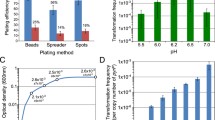Abstract
Preformed transposase-transposon complexes called ‘Transposomes’ have been electroporated into bacterial cells. The magnesium dependent process of insertion of the transposable element into bacterial chromosomal DNA occurs in vivo. The transposition efficiency of a Transposome containing a kanamycin marker was between 1.0 × 104and 1.0 × 107kanamycin resistant clones per microgram of transposon DNA in three gram-negative enteric bacterial species. Transposon integration sites were examined by direct genome sequencing of chromosomal DNA. Genomic DNA was isolated from transposition clones and directly cycle sequenced with primers specific for the ends of the transposon. The precise location of genome interruption for a transposition clone was identified by homology to known genes or sequences. Mutant phenotypes were rapidly correlated with genomic insertions sites.
Similar content being viewed by others
References
Alm, R.A. & J.S. Mattick, 1995. Identification of a gene, PilV, required for type 4 fimbrial biogenesis in Pseudomonas aeruginosa, whose product possesses a pre-pilin-like leader sequence. Mol. Microbiol. 16: 485.
Brow, M.A.D. et al., 1996. Differentiation of bacterial 16S rRNA genes and intergenic regions and Mycobacterium tuberculosis katGgenes by structure-specific endonuclease cleavage. J. Clin. Micro. 34: 3129.
Goryshin, I. Yu. & W.S. Reznikoff, 1998. Tn5 in vitrotransposition. J. Biol. Chem. 273: 7367.
Goryshin, I. Yu. et al., 2000. Insertional transposon mutagenesis by electroporation of released Tn5 transposition complexes, Nature Biotechnol. 18: 97.
Heiner, C.R. et al., 1998. Sequencing mutimegabase-template DNA with BigDye terminator chemistry. Genome Res. 8: 557.
Hoffman LM et al., 1999. In vivotransposition of transposon/ transposase complexes into the genome of Saccharomyces, Current Genet. 35: 305.
Kolter, R., M. Inuzuka & D.R. Helinski, 1978. Trans-complementation-dependent replication of a low molecular weight origin fragment from plasmid R6K. Cell 15: 1199.
Metcalf, W.W.,W., Jiang & B.L Wanner, 1994. Use of the rep technique for allele replacement to construct new Escherichia colihosts for maintenance of R6K gamma origin plasmids at different copy numbers. Gene 138: 1.
Mueller, J.G. et al., 1997. Phylogenetic and physiological comparisons of PAH-degrading bacteria from geographically diverse soils. Antonie Van Leeuwenhoek 71: 329.
Wach, A. et al., 1994. New heterologous modules for classical or PCR-based gene disruptions in Saccharomyces cerevisiae. Yeast 10: 1793.
York, D. et al., 1998. Simple and efficient generation in vitroof nested deletions and inversions: Tn5 intramolecular transposition. Nucleic Acids Res. 26: 1927.
Zhou, M., A. Bhasin & W.S. Reznikoff, 1998. Molecular genetic analysis of transposase-end sequence recognition: cooperation of three adjacent base pairs in specific interaction with a mutant Tn5 transposase. J. Mol. Biol. 276: 913.
Author information
Authors and Affiliations
Rights and permissions
About this article
Cite this article
Hoffman, L.M., Jendrisak, J.J., Meis, R.J. et al. Transposome Insertional Mutagenesis and Direct Sequencing of Microbial Genomes. Genetica 108, 19–24 (2000). https://doi.org/10.1023/A:1004083307819
Issue Date:
DOI: https://doi.org/10.1023/A:1004083307819




